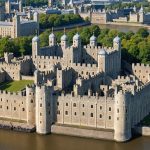Overview of the Tower of London
The Tower of London stands as a bastion of British history and is recognized for its historical significance. Established in 1066 by William the Conqueror, it exemplifies Norman military architecture. Its imposing White Tower, built in 1078, is a notable feature representing the Tower’s architectural evolution.
Constructed over the centuries, the Tower of London comprises various buildings and fortress elements reflective of different architectural styles. The medieval architecture is predominant, but it also integrates Gothic elements added in subsequent enhancements.
In the same genre : Unveiling britain”s secluded historical gems: essential tips for your countryside adventure
The cultural impact of the Tower cannot be overstated. It has been pivotal throughout England’s history, serving various roles—from royal palace to prison. Moreover, its designation as a UNESCO World Heritage site affirms its importance on a global scale.
The Tower not only enchants with its formidable architecture but also with its stories of royal intrigue, serving as a symbol of British sovereignty and resilience. Visitors today can witness the Tower’s evolution, appreciating its architectural diversity and understanding its enduring role in safeguarding heritage. The iconic landmarks of the Tower continue to captivate and educate millions of visitors each year.
Topic to read : Discover the charm of cotswolds: your complete guide to an unforgettable walking tour of historic market towns
Historical Timeline
The Tower of London’s history is rich with significant events that have shaped its legacy. It was initially established by William the Conqueror in 1066. The Tower has witnessed numerous key milestones throughout the centuries.
Major Events and Transformations
Over the centuries, the Tower of London has been the backdrop for many major events. Perhaps one of the most notorious was the imprisonment and execution of Anne Boleyn in 1536. Her story alone underscores the Tower’s pivotal role during the Tudor reign. During the reign of King Henry III and Edward I, the Tower underwent significant expansions, reflecting their strategic intentions.
Influential Reigns
The Tower has been influenced profoundly by various monarchs. Notable reigns, including that of Richard the Lionheart, altered the Tower’s purpose, transforming it from a royal residence to a formidable fortress.
Legacy of Change
As centuries passed, the Tower evolved, reflecting broader historical shifts. It shifted from a defensive stronghold and prison to a site of cultural heritage. The creation of the Crown Jewels’ display in the 17th century marked a transformation in its public role, ensuring the Tower’s continued prominence within British history.
Current Role and Preservation
In today’s world, the Tower of London’s modern significance is rooted in its robust preservation efforts. These initiatives are critical to maintaining the Tower’s architectural integrity and ensuring its continued contribution to cultural heritage. Preservation projects focus on structural restorations and preventing deterioration, guided by expert conservationists who assess and execute necessary interventions.
The Tower’s contemporary role extends beyond its historical origins. It serves as a vibrant hub for education and research, offering insights into Britain’s storied past. Exhibitions and programs are continuously updated to engage a changing audience, fostering a deeper cultural connection. This ensures that the Tower remains relevant and accessible to both local and international visitors.
Looking ahead, future plans centre around enhancing visitor experiences while prioritising preservation. Advances in technology and curation offer dynamic ways to present the Tower’s rich history, such as via virtual reality tours and interactive displays. These innovations promise to captivate upcoming generations.
Overall, the Tower of London’s commitment to preservation underpins its enduring importance. It connects past and future by honouring its rich legacy and adapting to contemporary cultural contexts, ensuring that its iconic landmarks continue to teach and inspire.
Architecture and Design
The Tower of London architecture showcases a tapestry of styles reflecting its long history. The White Tower, built in 1078, exemplifies Norman design with its robust structure serving defensive purposes. It stands as one of the most crucial components, featuring thick walls and small windows typical of its era. The later medieval additions introduced Gothic elements, notably in chapels and additional fortifications.
The Edwardian fortifications, initiated by Edward I, expanded the Tower’s functions and reinforced its role as a military stronghold. Key architectural features include the concentric castle design, which enhanced defense with multiple layers of walls and strategic positioning of turrets and towers.
This fusion of styles not only bolstered defenses but also illustrated shifts in construction techniques over centuries. Integrating architectural innovation, the complex incorporated both aesthetic and functional elements, balancing the grandeur suitable for royalty and the fortifications necessary for security.
The architecture strategically marries beauty and utility, showcasing the Tower’s adaptation through time. These features embody the Tower’s resilience and evolving purpose, reflecting broader historical contexts and advancements, making it an architectural study rich in depth and historical significance.
Notable Figures Associated with the Tower
The Tower of London has long been intertwined with significant historical figures who have shaped its legacy. Among these are the prominent prisoners such as Anne Boleyn, whose tragic end in 1536 remains a compelling story of intrigue and betrayal. Her presence underscores the Tower’s role as a prison entwined with royal drama.
Numerous historic monarchs have left their mark on the Tower, including Richard the Lionheart and King Henry III, each contributing to its evolution from a royal residence to a formidable fortress. Their influence is evident in the architectural advances and strategic modifications that occurred during their reigns.
Beyond royalty, various other historical figures have contributed to the Tower’s legacy, be it through construction projects, changes in its purpose, or their sheer presence in times of upheaval. For instance, Guy Fawkes was interrogated here after his plot to blow up Parliament was foiled.
The stories of these individuals, whether noble or notorious, enrich the narrative of the Tower, providing visitors with a deeper understanding of its complex past. The intertwining of these personal tales with the broader historical context makes the Tower a living museum of history.
Artifacts and Treasures
The Tower of London artifacts offer a glimpse into the opulent past of British royalty, with the Crown Jewels being the most celebrated collection. Comprising crowns, sceptres, orbs, and ceremonial objects used in state events, the Jewels play a key role in the country’s monarchy. They include the iconic St Edward’s Crown and the Jewel House’s other regal treasures, embodying centuries of tradition and pageantry.
Beyond these illustrious jewels, the Tower also houses other historical treasures that contribute to its rich narrative. Among them are ancient armoury displays and relics that showcase England’s evolving defence mechanisms. Each piece tells a unique story, revealing insights into the historical contexts of different eras.
The significance of these artifacts extends beyond aesthetics; they are pivotal in understanding Britain’s history and identity. Curated responsibly, these treasures help preserve the legacy of governance and splendour that characterizes the British monarchy. For visitors, the exploration of these collections provides a comprehensive understanding of the Tower’s past, making their experience educational as well as awe-inspiring.
Legends and Myths
The Tower of London is steeped in legends and ghost stories that captivate visitors and historians alike. These tales, rooted in historical events, have significantly impacted popular culture.
One of the most famous legends involves the ghost of Anne Boleyn, who was executed at the Tower in 1536. It is said that her spirit still roams the corridors, head tucked under her arm, a chilling reminder of the Tower’s turbulent past. Such stories of ghostly apparitions are not uncommon, with reports of eerie sounds and spectral figures adding to the Tower’s mystique.
Another legend is that of the ravens. Tradition holds that at least six ravens must remain at the Tower to prevent the kingdom from falling. This belief has led to the careful care and management of a resident raven population, intertwining myth with daily routine.
Myths like these contribute to the Tower’s cultural heritage, attracting those fascinated by Britain’s enigmatic history. Their allure extends beyond mere ghost stories; they are narrative threads interwoven with historical truths, enriching the experience of visiting this iconic landmark. The Tower’s legends continue to inspire curiosity and imagination, ensuring its place in both history and folklore.
Visitor Experience
A visit to the Tower of London promises an immersive journey through time. To make the most of your experience, planning is key. The Tower is open to visitors most days, typically from 9:00 AM to 5:30 PM. Entry fees vary, with discounts available for families, seniors, and children. It’s wise to purchase tickets in advance, especially during peak tourist seasons.
Recommendations for the best times to visit include early mornings or late afternoons. These times often see fewer crowds, allowing for a more leisurely exploration of the Tower’s attractions.
Once inside, visitors are encouraged to explore the iconic landmarks. Notable exhibits include the Crown Jewels, which dazzle with their splendor and storied past. Tours are available, led by knowledgeable Beefeaters who share captivating anecdotes and the Tower’s history. Don’t miss the White Tower and its vast armory collection.
For those interested in the Tower’s lower-profile inhabitants, don’t overlook the ravens. Their presence contributes to the Tower’s cultural heritage and is intertwined with its legends. Embrace the blend of history and folklore, ensuring a memorable and educational experience at one of Britain’s most famous sites.











